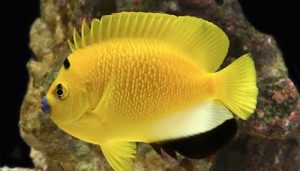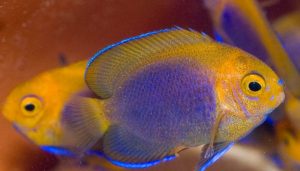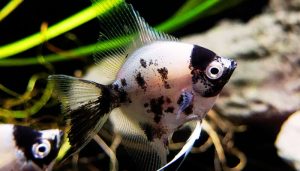Are you looking for a stunning and unique angelfish for your aquarium? Leopoldi Angelfish – Care Guide for Pterophyllum leopoldi is here to help you understand this lesser-known yet beautiful species. This guide covers everything from tank setup to feeding and breeding tips.
Leopoldi angelfish, often mistaken for other angelfish species, require specific care to thrive. They need warm, soft water, a spacious tank, and a well-balanced diet. With proper care, these fish can live up to 10 years, making them a rewarding choice for dedicated aquarists.
But there’s more to keeping them than just the basics. Experts like Heiko Bleher, a renowned fish explorer, emphasize the importance of stable water conditions and compatible tank mates. So, let’s dive in and explore how to create the perfect environment for your Long Nose Angelfish!
Table of Contents
ToggleHow Big Do Leopoldi Angelfish Get: (Leopoldi Angelfish Size)
Leopoldi Angelfish typically reach a size of about 4 to 5 inches in length. However, their size can vary depending on their environment and the care they receive in the aquarium. In well-maintained conditions with optimal water parameters, these angelfish can grow to their full potential, displaying their beautiful dorsal and ventral fins.
Their relatively smaller size compared to other angelfish species, such as the scalare, makes them an excellent choice for hobbyists with smaller freshwater aquariums. Additionally, the sexual dimorphism is subtle but can be observed, with males generally developing more pronounced anal fins and a more robust body shape.
In optimal conditions, some Pterophyllum leopoldi may even exceed the typical size, reaching up to 6 inches under ideal circumstances.
It’s essential to provide enough tank size and proper diet, as a well-balanced diet of live or frozen foods like brine shrimp, mosquito larva, bloodworm, and daphnia contributes significantly to their growth.
The tank should ideally allow ample swimming space and provide suitable substrate and decorations to mimic their natural habitat. By maintaining a proper aquarium environment, hobbyists can ensure that their Angelfish Leopoldi thrive and exhibit their best physical characteristics, including their stunning colors and fin shapes.
Leopoldi Angelfish Natural Habitat
The natural habitat of the Leopoldi Angelfish is primarily found in the slow-moving waters of the Rupununi and essequibo river drainage in Guyana, as well as the Amazon River basin. These areas are characterized by broad-leaved vegetation and soft, acidic water, creating an ideal environment for these cichlids to thrive.
The angelfish tend to inhabit areas with plenty of hiding spots, which provide safety from predators and a place to spawn. The gentle currents in these rivers help maintain the stability of the water parameters, which are crucial for their health and well-being.
In their native habitat, Pterophyllum leopoldi often interact with various species, contributing to a diverse aquatic ecosystem. They are known to coexist with other South American cichlids, exhibiting both territorial and communal behaviors.
This adaptability in their natural environment allows them to adjust to various conditions, which can also be reflected in their care in a home aquarium. By replicating these natural settings with appropriate substrates and aquatic plants, aquarium enthusiasts can create a comfortable habitat for their Leopoldi Angelfish, ensuring they exhibit their natural behaviors and flourish in their new home.
How Do You Care for a Pterophyllum Leopoldi?
Caring for Pterophyllum leopoldi requires attention to several key factors, including tank size, water parameters, and diet. A minimum tank size of 30 gallons is recommended for a small group of these angelfish, as they appreciate having space to swim and explore.
Maintaining stable water parameters is essential, with a pH level between 6.0 and 7.5, soft to moderately hard water, and regular water changes to keep nitrate levels low. Regular water changes help simulate their natural environment and promote the overall health of the fish.
In terms of leopold’s angelfish diet, Roman Angelfish thrive on a varied diet that includes high-quality pellets, live or frozen foods such as brine shrimp, bloodworm, and daphnia. Providing a mix of these food sources ensures they receive the necessary nutrients for growth and vitality.
It’s also important to observe their behavior during feeding to ensure that all tankmates are getting their share. Additionally, the presence of appropriate tankmates can positively influence their social behavior, making them feel secure and less stressed in the aquarium environment.
Regular monitoring of their health, along with preventive measures against common diseases, will also contribute to the longevity and happiness of these enchanting fish.
Longnose – Pterophyllum leopoldi Water Parameters
For optimal health, the water parameters for Pterophyllum leopoldi should be carefully monitored and maintained. Ideal conditions include a temperature range of 75°F to 82°F, a pH level between 6.0 and 7.5, and soft to moderately hard water with a hardness of 3-12 dGH.
It is crucial to keep nitrate levels low, ideally below 20 ppm, as high nitrate can lead to health issues. Regular water changes, typically 10-20% weekly, help maintain these parameters and provide a stable environment that mimics their natural habitat in the Essequibo and Rupununi rivers.
In addition to temperature and pH, the aquarium setup should include ample hiding spots and broad-leaved plants to replicate their natural environment. This will not only help in maintaining water quality but also provide security and comfort to the fish.
Monitoring the Water Conditions regularly with reliable test kits is essential, as fluctuations can stress the fish and lead to diseases. Ensuring that these angelfish have stable and clean water conditions will ultimately lead to a thriving aquarium filled with vibrant Pterophyllum leopoldi.
Where can I Find Leopoldi Angelfish for Sale?
Finding Leopoldi Angelfish for sale can be an exciting venture for aquarium enthusiasts. Many local fish stores carry a selection of cichlid species, including Pterophyllum leopoldi, particularly those that specialize in South American fish.
Additionally, online retailers and aquarium clubs often list wild-caught and captively bred Angelfish Leopoldi for sale. It’s important to research the source to ensure that the fish are healthy and ethically sourced, as the quality of the fish can vary significantly between sellers.
When purchasing Long Nose Angelfish, be sure to inquire about their health and care history. If possible, observe the fish in their current environment to check for signs of disease or stress.
Some hobbyists may also prefer to adopt from local breeders or aquarium societies, where the fish are often raised in optimal conditions and are more likely to adapt well to a new home.
Regardless of where you choose to buy your angelfish, ensuring you are getting a healthy specimen will set the stage for a successful and rewarding aquarium experience.
What Is the World’s Smallest Angelfish?
The world’s smallest angelfish is often considered to be the Dwarf Angelfish (Centropyge), which typically grows to about 3 to 4 inches in length. This species is distinct from the Pterophyllum genus but offers a compact option for aquarists looking for smaller cichlids.
In contrast, the Roman Angelfish, while not the smallest, still remains relatively diminutive compared to other species within the Pterophyllum genus, making it an attractive choice for various aquarium setups. The Dwarf Angelfish is popular among hobbyists for its vibrant colors and manageable size, which allows it to thrive in smaller tanks.
While Pterophyllum leopoldi are not the smallest angelfish, their unique traits and easy care requirements make them a preferred option for many aquarists. Understanding the differences between angelfish species, including size, temperament, and care needs, is crucial for anyone looking to establish a diverse and healthy aquarium.
By considering the various angelfish species available, hobbyists can create a dynamic aquatic environment that showcases the beauty and diversity of these captivating aquarium fish.
This is an impressive species that, while smaller than congener, still needs a taller-than-usual aquarium because of its adult size and lengthy trailing fins. It requires soft, acidic water with minimal hardness.
Conclusion
In conclusion, the Long Nose Angelfish, or Pterophyllum leopoldi, is a delightful addition to any freshwater aquarium. With proper care, including optimal water parameters, a suitable diet, and a spacious tank, these cichlids can thrive and bring vibrant color to your aquatic setup. Their natural habitat in the rivers of Guyana provides insight into their care requirements, allowing hobbyists to create an environment that reflects their needs. As you explore options for purchasing these angelfish, remember to seek healthy, ethically sourced specimens to ensure a rewarding aquarium experience. Whether you are a seasoned aquarist or a beginner, caring for Leopoldi Angelfish can be a fulfilling journey that enhances your appreciation for the beauty of aquatic life.
ٌRecommended posts
- The Angelfish History – Their Origins & Aquarium Journey
- Exploring the Angelfish Natural Habitat: Rivers & Ecosystems




